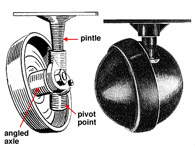
Shepherd castors
1946
steerable wheel for movable furniture
George Shepherd was a wealthy Melbourne oil company executive who regularly played bridge (a card game) with his society chums, sitting around in big, comfy club sofa chairs. He found that the tiny castor wheels fitted to the chairs made them very hard to move.
So from 1934 until 1939 Shepherd researched the physics of existing castors and proposed a new type of wheel that swivelled on an angled axle. With the weight of the chair offset from and below the axle, the wheel could be steered with much less effort.
Shepherd made 60 different versions by hand in 1939 and fitted them to the furniture in his house. This was just in time, because his wife broke her ankle and needed a free-moving chair to get around the house.
Shortages of labour and materials in World War II frustrated his attempts to manufacture castors, but in 1946 his associate Mark Cowen set up Shepherd Castors Pty Ltd to mass produce them.
The final design encloses the axle and pintle in an attractive dustproof dome, perfect for both 'high class' furniture and dirty industrial applications. Shepherd castors were eventually made under licence in 17 countries and an estimated 300 million have been sold.
George Shepherd used some of his fortune to set up the Shepherd Foundation in Victoria, a charitable medical diagnostic centre.
Who Did It?
Key Organisations
Shepherd Castors Pty Ltd : design, manufacture
Key People
George Shepherd : inventor
Mark Cowen : manufacturer
Further Reading
Inventive Vics exhibition
E Gold and R Greener
Museum of Victoria, Melbourne, 1985, pp 42-44.
Links
Patent
example
|










